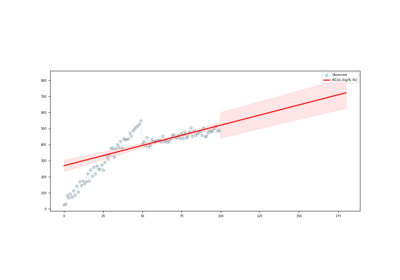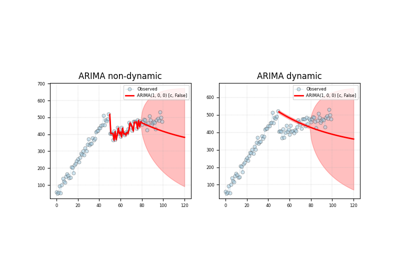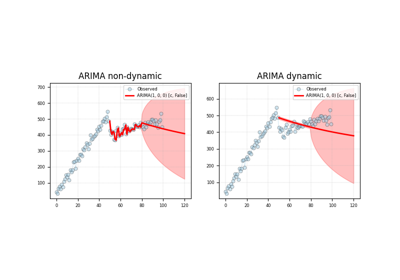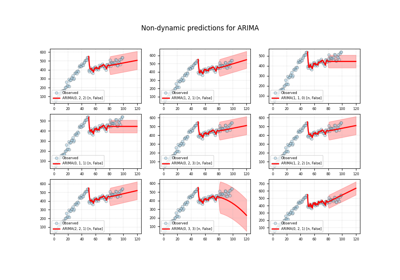pyamr.core.regression.arima
Classes
- class pyamr.core.regression.arima.ARIMAWrapper(estimator=None, evaluate=True)[source]
Methods:
as_summary(**kwargs)Returns a summary string (statsmodels inspired)
auto(endog[, exog, ic, trends, max_ar, ...])Find the best model through bruteforce.
conf_int_forecast(predictions[, alpha])Computes the out-sample confidence interval.
evaluate([alpha])Generates a dictionary with the relevant attributes.
get_prediction([start, end, alpha])Calls the predict function in ARIMA.
- auto(endog, exog=None, ic='bic', trends=['n', 'c'], max_ar=3, max_ma=3, max_d=1, warn='ignore', return_fits=False, converged=True, disp=0, verbose=0, **kwargs)[source]
Find the best model through bruteforce.
Note: It uses grid search through the base wrapper.
- Parameters:
endog (array-like) – The endogenous variable (aka. time series data)
exog (array-like) – The exogenous variable (by default is the time t starting in 0)
ic (string) – The information criteria which should be any of the params which are set in the wrapper (see method _init_result).
max_ar (number) – The maximum autorregresive order to inspect.
max_ma (number) – The maximum moving average order to inspect.
max_d (number) – The maximum difference to inspect.
warn (string, options = {ignore, raise}) – Whether or not to ignore the warnings raised
return_fits (bool) – Whether or not to return all the fits. If false only the best model is returned. If true all the models and the best model are returned separately.
converged (bool) – Whether or not to return only converging models. If false all models are returned. If true, only those models that converged are returned.
- conf_int_forecast(predictions, alpha=0.05)[source]
Computes the out-sample confidence interval.
- Parameters:
predictions (array-like) – The predictions done by the model.
alpha (int) – The alpha to configure the confidence interval.
- Return type:
array-like
- evaluate(alpha=0.05)[source]
Generates a dictionary with the relevant attributes.
Note
There is an issue with the method conf_int(alpha). It can receive as input parameters a pandas series or a numpy array. We are using it with numpy array as input, hence when pandas series is passed the method _init_result gives an error.
Include ref to statsmodels:Arima and statsmodels:ArimaResults.
- Parameters:
alpha (the confidence interval.)
- Returns:
dictionary
- Return type:
map with all the parameters.
- get_prediction(start=None, end=None, alpha=0.05, **kwargs)[source]
Calls the predict function in ARIMA.
Note
The confidence intervals have been implemented using the following functions
_forecast_conf_int()and_forecast_error(). These are implemented instatsmodels.ts.arima_model.ARIMAResults. As such, it produces the same confidence intervals than the methodplot_predict().Note
The parameter start refers to the original series. As such, if the series has been differenced (e.g. d=1) the first observation has been lost. In those cases, start has to be greater or equal to d.
Todo
Review the predictions when dynamic is set to true.
Review the confidence intervals (in and out sample)
Review the prediction intervals.
- Parameters:
start (int (optional)) – The time t to start the prediction
end (int (optional)) – The time t to end the prediction
dynamic (bool) – The dynamic keyword affects in-sample prediction. If dynamic is false then the in-sample lagged values are used for prediction. if dynamic is true, then in-sample forecasts are used in place of lagged dependent variables. The first forecasted value is start.
alpha (float) – The alpha value when creating the norm point percent function to compute the confidence intervals for the forecast predictions.
typ (string-like, options = {linear, levels}) – Wether to predict the original levels (levels) or predict in terms of the differenced endogenous variables.
- Return type:
matrix



